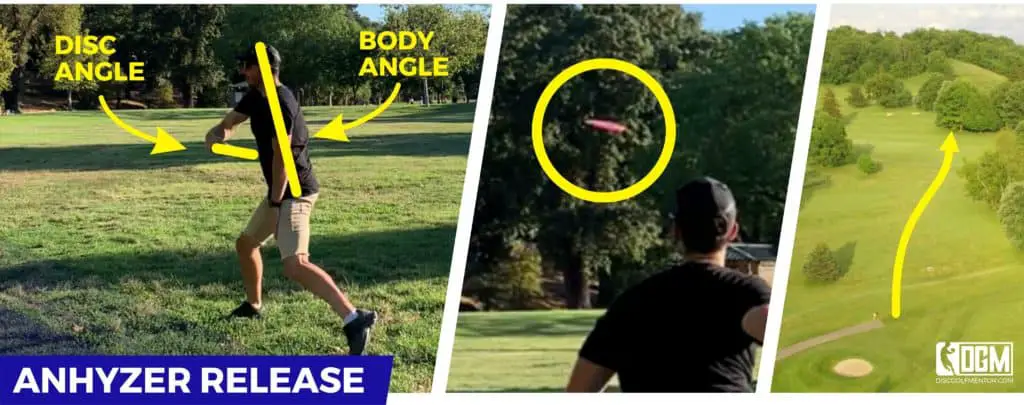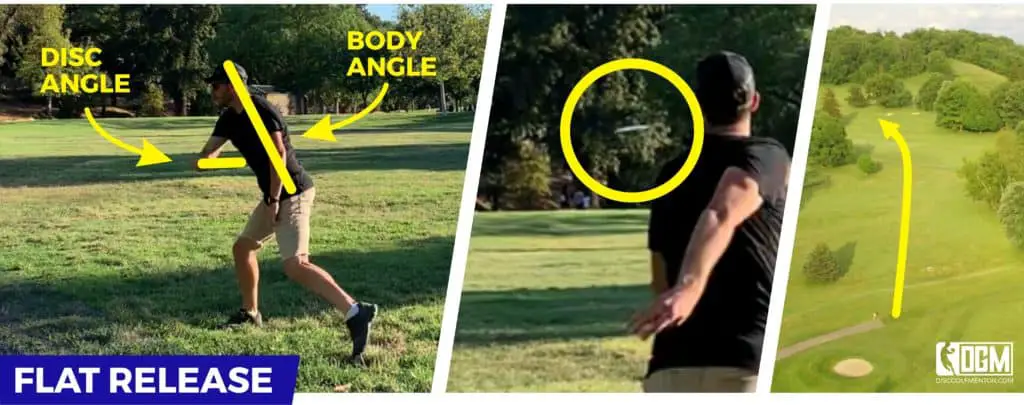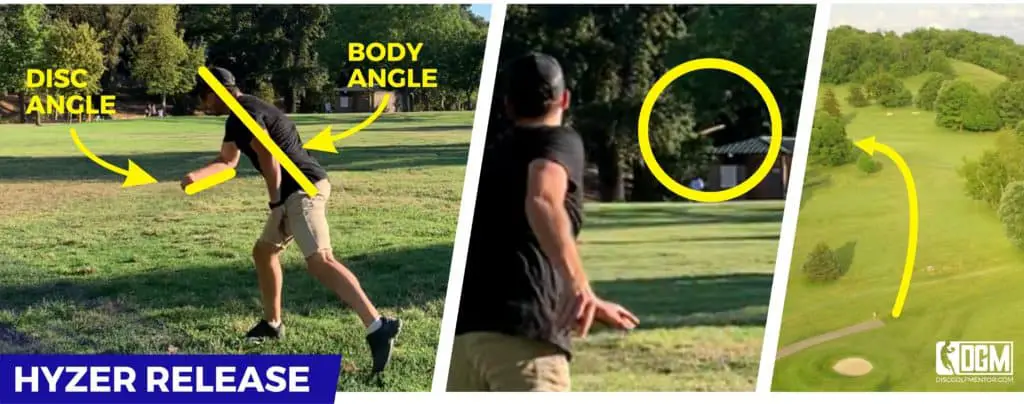As you gain more experience playing disc golf, you will likely start to hear some new terms that are unique to the sport. One of those terms is “anhyzer”. If you haven’t heard the term “anhyzer” before, don’t worry. We’re going to talk about exactly how to throw anhyzer in this article. First, let’s cover what it means now.
What is Anhyzer?
In disc golf, throwing anhyzer means releasing the disc at an angle, which will change the normal flightpath of the disc. For right handed players, an anhyzer angle will make the disc turn right.
The disc will always try to fade back to the left in the last part of the flight. But the initial angle of release determines how the disc flies in the turn, which is the first part of the flight path. Hyzer makes the disc go more left. Flat makes the disc fly straight, and Anhyzer makes the disc fly to the left. To make things a little bit more clear, I’ve drawn up some diagrams to help illustrate what the angles do:



An important note about anhyzer, and really any of the release angles, is that most players think this angle is achieved by tilting your wrist. But by tilting the wrist, you could be throwing off your form or even damaging your wrist.
Instead of changing your wrist angle, try letting the angle of your upper body determine the angle of your disc. If you keep your arm in it’s normal position, but lean your body back slightly, you’ll notice that your disc will tilt. That’s how you achieve the anhyzer angle.
Nerd Alert
The term anhyzer actually comes from the throw being the opposite of a hyzer. Hyzer is another type of disc golf throw that accentuates the fade rather than fighting against it. So, if you’re right-handed, the disc will fly more to the left than it would if you were to throw it flat
The hyzer throw is named after H.R. ‘Fling’ Hyzer who was an influential disc golf player. (You can learn more about him here) Anhyzer is simply the opposite of hyzer, which means the disc will fly towards the direction of your throwing hand. So, if you are right-handed, the disc will curve to the right.
When Do You Use an Anhyzer Shot?
When to use a specific type of shot will depend on a player’s personal preferences and abilities. There are some common situations where an anhyzer shot will be useful. In these examples, we are assuming that the player is right-hand. (For left-handed players, just reverse the directions.)
If the path of the hole curves to the right, then you could use an anhyzer throw so that the disc follows the curve of the course. Another scenario where anhyzer is useful is when you encounter obstacles. If there is an obstacle in front of you, you could throw to the left of it using the anhyzer throw. The disc would curve back to the right to land straight in front of you.
Anhyzer is also important when scrambling to get out of some bushes. You may only have a clear path out and around an obstacle to the right… Basically, anytime you want the disc to curve opposite it’s natural fade, an anhyzer throw will come in handy.
Why is Anhyzer Used Less Often?
You may notice that people use the hyzer shot a lot more often than the anhyzer. The anhyzer throw is slightly more difficult, which may be part of the reason. The main reason is because the hyzer throw can be a lot more forgiving in terms of accuracy. Changes in the angle of a hyzer throw will only have a slight impact on where the disc flies and where it lands. With an anhyzer throw, the angle you are holding the disc at will make a big difference in where the disc flies and lands. Because of this, a little mistake throwing anhyzer can put you way off course. Throwing a hyzer is often the safer choice. The trade off is that the anhyzer throw will go farther. A disc thrown anhyzer should travel a lot farther than a disc thrown hyzer at the same speed. This is because it still has the fade, which will bring it out of the anhyzer angle to finish left. If you’ve given it enough height that is.
How to Throw Anhyzer?
An anhyzer release is achieved by throwing the disc at an angle when you release it. As I said earlier, you’ll want to keep you’re wrist in it’s normal, flat, comfortable throwing position. But tilt your body slightly backwards. It will feel strange at first, but the more you throw it, the more comfortable it will become as you make adjustments to your body position.
For your footwork, you may want to offset your front foot slightly more to the left of your back foot. (As a right handed player). Throwing anhyzer tends to open up the chest more and this will allow you to stay on target rather than releasing too far to the right.
Another difference with anhyzer is that your arm will finish low behind you. It almost feels like you’re throwing towards the ground, but it’s just the angle of the disc forcing your arm downwards in your swing.
What disc should you use to throw Anhyzer?
When throwing anhyzer, the best disc to choose will really depend on the situation at hand and you’re level of skill. If you want the disc to turn right, then fight the turn and finish left, you should pick an overstable disc. If you want the disc to slowly turn right and typically stay on that right turning flight with very little fade, then a stable disc is a better choice. Want a hard right turn with hardly any fade? I’d go with an understandable disc.
You can normally determine a disc’s stability by looking at the turn rating which goes from 1 to -5. Turn ratings from -3 to -5 are understable, discs rated from -2 to 0 are more stable and discs rated from 0 to 1 tend to be overstable. Then, if you look at the fade rating, you’ll be able to tell how much the disc will fight the turn. A high rating of 4-5 will come out of the turn very quickly. While a low rating of 0 will probably not come out of that right turn at all.
If you want to try a stable disc, the Innova Beast is a great stable driver for beginners. Check out our stable disc recommendations. If you want to try with an understable disc, the Innova Valkyrie is another great option for beginners. Check out our recommendations for understable discs.
Pro Tip: The Roller!
The roller is a great shot to perform. It’s achieved by using an anhyzer release while throwing an understandable disc. Preferrably a very understable disc or a beat in disc. A great disc choice is the Innova Roadrunner, and if you’d like to learn how to throw this type of shot, I cover it step by step right here. If you need more disc recommendations for rollers, you can see our recommendations for understable discs here.
Tips and Common Mistakes
The anhyzer can be a tricky shot to master. There are several components of a disc golf shot that need to come together to execute it properly. In addition to the basics of how to throw anhyzer that we already covered, here are some tips and common mistakes to keep in mind:
Rounding
Make sure you are not rounding. Rounding is a very common mistake in every throw. If you are rounding, you will not be able to throw anhyzer properly. If you want to learn what rounding is and how to fix it, check out this article for tips on fixing rounding problems.
Keep your hand on the outside of the disc. Often, people turn the disc slightly so their hand ends up at the front with the disc behind it. Your hand should be on the outside of the disc, so as you throw the disc will be between your hand and your body. This will make it easier to maintain your anhyzer angle.
Holding the disc too close to your body during pull-through is a common mistake. Often players hit themselves slightly with the disc, throwing off the angle. You still want to be very close to your body, but just make sure that you are giving the disc enough space as you pull through.
Follow-through
Don’t be afraid to follow-through downward. It may feel like you are going to throw the disc into the ground but that won’t happen if you release properly. Check out this article for tips on follow-through.
Remember that the curve in the disc’s flight path will take up some of the distance it travels. Adjust your throw speed to compensate for the sideways distance that the disc travels.
Angle
Some players tend to draw the disc back when they are setting it at an angle. Makes sure to keep your hand at the side of the disc.
You need more angle than you think. Novice players tend to hold the disc with less of an angle than they need to throw anhyzer.
Keep the nose flat or tilted very slightly downward. This refers to the angle of the disc from front to back with the nose being the front of the disc. You want the speed of the disc to be what lifts it. If you have an upward angle, it will draw air under the disc creating lift and the power you put into the throw will go into lifting the disc up, rather than driving it forward.
Learning the Anhyzer Throw
The anhyzer throw can be a challenging shot. If you are just starting out, it may be better to focus on getting some basic shots down first. Most players will start off learning straight shots and focusing on proper form for different drives, approaches and putts. If you are trying to gradually move up in complexity, you may want to learn forehand shots next and then hyzer.
Alternatively, some people recommend learning anhyzer early. Because anhyzer involves a more complicated form and flight path, it is good for teaching novices about all the components that go into a throw and how little variations can affect the flight path. We would only recommend this approach if you are working with a coach or someone who can teach anhyzer to you properly and explain these components.
Straight, hyzer and anhyzer make up the basic throw angles, but disc gold throws can get even more complicated. Once you have the basic angle throws under control, you can start working on more advanced flight paths like hyzer flips and s-curves.
Related Questions:
How do you throw hyzer?
- To throw a hyzer in disc golf, tilt the furthest edge of the disc upwards by leaning your body slightly back. This will cause the disc to turn more heavily. If you’re a right handed player, this means that the disc will fly towards the left.
What type of throw goes farthest in disc golf?
- The disc golf throw that will travel the longest distance depends on the player’s abilities. Advanced players commonly throw a backhand drive with a hyzer flip to get the most distance. Another common long distance shot it the S shot using an understable disc. You can learn more about these shots and how to throw them in our throwing styles guide here.